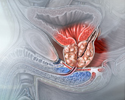Cryotherapy for prostate cancer
Cryosurgery - prostate cancer; Cryoablation - prostate cancerCryotherapy uses very cold temperatures to freeze and kill prostate cancer cells. The goal of cryosurgery is to destroy the entire prostate gland and possibly surrounding tissue.
Cryosurgery is generally not used as a first treatment for prostate cancer.
- What Happens During Cryotherapy
Before the procedure, you will be given medicine so that you do not feel pain. You may receive:
- A sedative to make you drowsy and numbing medicine on your perineum. This is the area between the anus and scrotum.
- Anesthesia. With spinal anesthesia, you will be drowsy but awake, and numb below the waist. With general anesthesia, you will be asleep and pain-free.
First, you will get a urinary catheter that will stay in place for about 3 weeks after the procedure.
- During the procedure, the surgeon places needles through the skin of the perineum into the prostate.
- Ultrasound is used to guide the needles to the prostate gland.
- Then, very cold gas passes through the needles, creating ice balls that destroy the prostate gland tissue.
- Warm salt water will flow through the catheter to keep your urethra (the tube from the bladder to outside the body) from freezing.
Cryosurgery is most often a 2-hour outpatient procedure. Some people may need to stay in the hospital overnight.
- When Cryosurgery is Used to Treat Prostate Cancer
This therapy is not as commonly used and is not as well accepted as other treatments for prostate cancer. Doctors do not know for certain how well cryosurgery works over time. There is not enough data to compare it with standard prostatectomy, radiation treatment, or brachytherapy.
It can only treat prostate cancer that has not spread beyond the prostate. Men who cannot have surgery because of their age or other health problems may have cryosurgery instead. It also may be used if cancer comes back after other treatments.
It is generally not helpful for men with very large prostate glands.
- Side Effects
Possible short-term side effects of cryotherapy for prostate cancer include:
- Blood in the urine
- Trouble passing urine
- Swelling of the penis or scrotum
- Problems controlling your urination (more likely if you have had radiation therapy also)
Possible long-term problems include:
- Erection problems in nearly all men
- Damage to the rectum
- A tube that forms between the rectum and the bladder, called a fistula (this is very rare)
- Problems with passing urine or controlling urination
- Scarring of the urethra and difficulty urinating
References
American Cancer Society website. Cryotherapy for prostate cancer. www.cancer.org/cancer/prostate-cancer/treating/cryosurgery.html. Updated November 22, 2023. Accessed January 18, 2024.
National Cancer Institute website. Cryosurgery to treat cancer. www.cancer.gov/about-cancer/treatment/types/surgery/cryosurgery. Updated June 21, 2021. Accessed January 18, 2024.
National Cancer Institute website. Prostate cancer treatment (PDQ) - health professional version. www.cancer.gov/types/prostate/hp/prostate-treatment-pdq. Updated February 13, 2023. Accessed January 18, 2024.
National Comprehensive Cancer Network website. NCCN clinical practice guidelines in oncology (NCCN guidelines): prostate cancer. Version 4.2023. www.nccn.org/professionals/physician_gls/pdf/prostate.pdf. Updated September 7, 2023. Accessed January 18, 2024.








